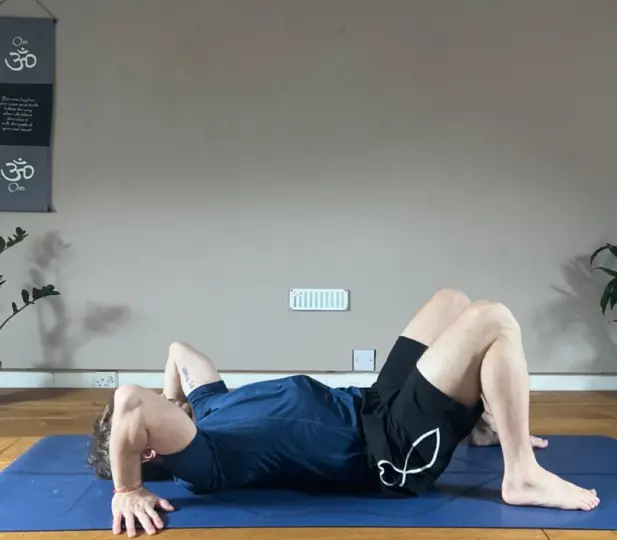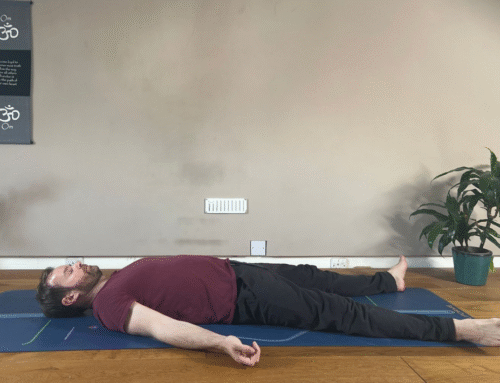
Full Wheel Pose: An Intermediate Asana Posture to Increase Energy and Well-Being
Hello, I’m Dav Jones, a dedicated yoga practitioner, and teacher trainer passionate about guiding individuals in their yoga practice and spiritual endeavors. Today, we’re going to take a look at Wheel Pose (Urdhva Dhanurasana), a strong asana from the backbend family. Together, we’ll dive into how to perform this pose correctly and safely, and I’ll share insights on how Wheel Pose can significantly enhance your flexibility, strength, and movement practice.
What is Full Wheel Pose (Urdhva Dhanurasana)?
Wheel Pose, also known as Upward Bow or Urdhva Dhanurasana, is a dynamic backbend that stretches the chest, abdominals, and anterior chain of the body. This pose of the backbend family helps to strengthen the shoulders, arms, legs, and back muscles and brings flexibility to the spinal column. It’s celebrated for its ability to energise the body, improve spinal flexibility, and stimulate the thyroid and pituitary glands. This pose is significant in yoga for its heart-opening qualities, promoting better respiratory function, and offering an uplifting effect on the physiology of the body. It’s a staple in many yoga sequences, aimed at building courage and expression.
Full Wheel Pose Yoga (Urdhva Dhanurasana) Basics
Sanskrit: Urdhva Dhanurasana
Pronunciation: OORD-vah don-your-AHS-ana
Meaning of Urdhva Dhanurasana: “Urdhva” means upward, and “Dhanura” means bow, reflecting the pose’s resemblance to an archer’s bow with the spine in extension. This posture symbolises the opening of the heart and chest, embodying an uplifting and energising effect.
Yoga Level: Intermediate to Advanced
Pose Type: Backbend
Preparatory Poses for Full Wheel Pose
Before attempting the Wheel Pose Yoga, it’s essential to properly warm up your body, particularly your spine, shoulders, and hips. Perform poses such as the Camel Pose, Cobra Pose, and Bridge Pose to prepare your body.

Camel Pose

Cobra Pose

Bridge Pose
Step-by-Step Approach to Full Wheel Pose: A Comprehensive Guide for All Levels
The Full Wheel Pose, also known as Chakrasana or Urdhva Dhanurasana, is an intermediate-to advanced-level backbend that requires flexibility and strength in the wrists, spine, shoulders, and hips. Here’s a step-by-step guide to performing the Wheel Pose safely:
Step 1.

Start Lying on Your Back: Begin by lying flat on your back. Bend your knees and set your feet on the ground, hip-width apart.
Step 2.

Position Your Hands: Place your palms on the ground beside your head, with your fingers pointing towards the long edges of the mat. Hug your elbows in towards each other.
Step 3.

Lift Your Hips: Press your feet and palms firmly into the ground, On the exhale, lift your hips off the floor whilst pushing down through your hands until you can place the crown of the head on the mat.
Step 4.

Press Into Your Hands: Aim to keep most of the weight in your hands and feet and only a small amount of weight on the head.
Step 5.

Rise Into Full Wheel Pose: On your exhale, push down through your hands, lifting your head off the floor completely, and work towards straightening your arms. Your body should now form an arch, resembling a wheel. Keep your feet parallel to each other and avoid letting your elbows splay out.
Step 6.

Hold the Pose: With enough dedicated practice of Full Wheel Pose, I noticed that my spine and shoulders opened up enough to express the posture like what you see in the image above.
Hold the pose for 5 to 10 breaths. Focus on pushing your chest back in a diagonally upward movement. Press down the ball of the big toe on each foot.
Step 7.
Exit the Pose: To come out of the pose, first tuck your chin to your chest. Then, bend your elbows and knees simultaneously, slowly lowering your back, shoulders, and head back to the floor. Rest on your back for a few moments, with the option to bring the knees into the chest to provide restoration for your spine.
Here are some quick tips for doing Wheel Pose Yoga that are useful for both beginner and advanced practitioners:
| Tips For Beginners | Tips For Advanced Practitioners |
|---|---|
| Warm Up: Warm up your wrists and spine considerably before approaching Full Wheel Pose. Start with a bridge pose to prepare your back and shoulders. |
Explore Variations: Try lifting one leg or arm to challenge balance. |
| Use Props: Place a block between the inner thighs. For some individuals, this can bring space into their lower back in the backbend.
Another alternative is to create a loop with a strap to the width of your hips. Step into the loop and place the strap above the knees. Press your thighs into the strap, keeping the strap at tension. For some practitioners, this can provide space for their lower back in the Full-Wheel Pose. |
Deepen the Backbend: Walk hands closer to your feet or lift heels onto the balls of your toes. |
| Feet Parallel: Keep feet hip-width apart, parallel to each other. | Breath Control: Use breath to deepen the pose; exhale deeper into the backbend. |
| Arm Strength: Strengthen arms in overhead arm position. Downward Facing Dog is also good for this. | Core stability: Aim to feel the stretch in the anterior body rather than feeling compressed in the lumbar spine. |
| Flexibility Focus: Practice doing stretches for the shoulders, spine, and hips. Explore different types of stretching modalities. | Endurance: Gradually increase the time you hold the pose. |
Benefits of doing Full Wheel Pose (Urdhva Dhanurasana)
Let’s explore some of the benefits of Full Wheel Pose – Urdhva Dhanurasana.
Benefits:
- Improves Spinal Flexibility: It deeply stretches the anterior (front) body, enhancing the flexibility of the spine in extension. This can help to ease tension in the chest, shoulders, and hip flexor region of the body.
- Strengthens Core and Limbs: This pose builds strength mainly in the posterior (back) body. Particular muscles like the Glutes, Hamstrings, Erector Spinae muscles, and Trapezius muscles all shorten to facilitate Full Wheel Pose.
- Opens the Shoulders: Full Wheel places the shoulders in end-range flexion. Over time, this backbend can gradually improve the range of the shoulder joint in flexion.
- Energises the Body: By stimulating the thyroid (in the throat) and pituitary (in the brain) glands, it can increase energy levels and help regulate metabolism.
- Enhances Emotional Well-being: The heart-opening aspect of the pose can help release emotional tension, promoting feelings of joy and well-being.
- Promotes Circulation: The inverted nature of the pose boosts blood circulation, which can rejuvenate skin, organs, and glands.
- Aids in Digestion: The stretching involved can stimulate the abdominal organs, potentially improving digestion and detoxification.
Modifications and props for Full Wheel Pose Yoga (Urdhva Dhanurasana)
These modifications and props can help tailor the Full Wheel Pose to your current level of flexibility and strength, making it a more inclusive and beneficial part of your yoga practice.
Yoga Blocks: Place a block between the thighs to help reduce compression in the lower back. Increasing the distance between the hands and the feet, can help make the pose more manageable for beginners or those with limited joint mobility.
Strap: Use a strap around your outer thighs to help bring more space to the lower back.
Wall: Practice Wheel Pose against a wall with the wrists/hands placed on yoga blocks at an angle to reduce potential strain on the wrist joint. This modification can also help the practitioner create more push through the arms, aiding more expression of Full Wheel Pose.
Elevated Surface: Raise the feet onto an elevated platform. This helps to reduce the extension of the spine, making the Full Wheel Pose more accessible for those with limited spinal extension.
Precautions for Full Wheel Pose Yoga (Urdhva Dhanurasana)
Practising Full Wheel Pose Yoga requires a diligent warm-up, and awareness of your personal limits. Take caution for those with shoulder, back, or wrist injuries. The use of props for support, firm placement of feet and hands, sensitivity to neck issues, and avoidance during pregnancy to ensure safety and minimise the risk of injury.
Final Thought
We’ve explored Full Wheel Pose, highlighting its techniques and benefits for enhancing your yoga asana practice. If you’re interested in deepening your practice, consider joining the Dav Jones Yoga membership online yoga classes on Patreon . If you’re looking for a more tailored/specific approach to your own personal practice, then take a look at the Dav Jones Yoga mentorship program.









